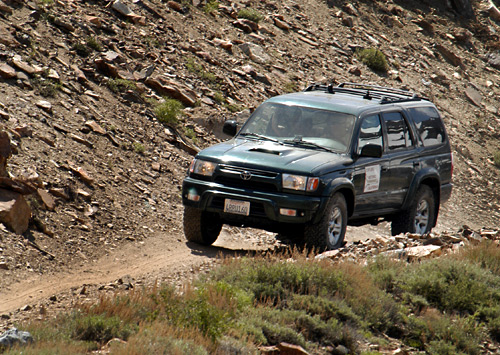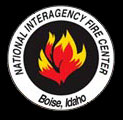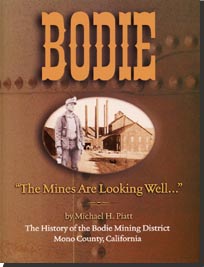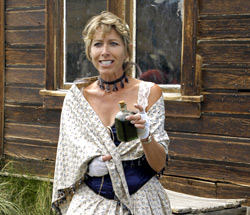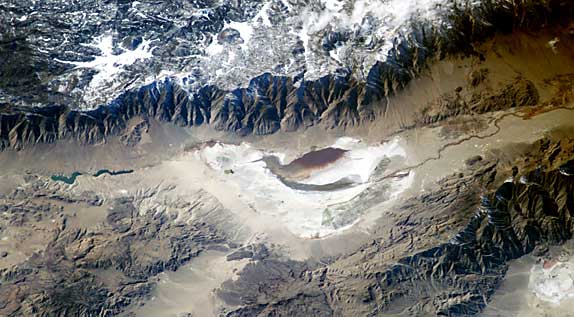|
|

|
Who Killed Hog Rogers? by Cecile Page Vargo |
|||||||||||||||||||||||||||||||||||||||||||||||||||||||||||||||
|
Back in the days when Owens Lake still had water in it, and the Owens Valley was full of both white and red men, a desperado by the name of John "Hog" Rogers lived near its shore. His dusty ranch was home to the hogs he had probably stolen, some poultry, and a big old vicious, but faithful dog named Jack. Hog Rogers Ranch was a popular spot for the teamsters coming and going along the trail in their big freight wagons full of supplies for the various towns and camps that had sprouted up in the Owens Valley and surrounding mountains. The teamsters were the ones who had dubbed Rogers the name "Hog" and he was quite proud of that. In return he provided a place where they could stop for refreshment before continuing on their journey.
One day, probably in the mid 1860's, the word was out that Hog's Ranch had been attacked by Paiutes. Self-proclaimed mountain man, Captain James Hobbs, had participated in rounding up quite a few of the Indians following a massacre of a Mexican party on their way to Saline Valley for salt. What Indians Hobbs and his men didn't kill, were quickly rid of their bows, arrows, and guns, and marched to Fort Independence where they were held as prisoner. It was said there were nearly two hundred of them, men women and children, all under the leadership of a chief who called himself Big Foot. The chief and the boys in blue at Fort Independence negotiated a peace treaty, but before the word could get out, warriors under different leadership staged that attack on Hog Rogers Ranch. Captain Hobbs and his men arrived at the ranch to find Hog had killed three Indians, and the rest had managed to escape. Chief Bigfoot had accompanied Hobbs in hopes of stopping any more violence amongst the warriors, but all Hog Rogers saw was another red man, and the old desperado side of him kicked in. Hog raised his rifle and took aim at Chief Bigfoot, killing him. Captain Hobbs was no Indian lover himself, and had a wealth of Indian battles under his own belt, but in the name of the peace treaty that Bigfoot had just signed, he was resigned to take Hog Rogers prisoner. Back at Fort Independence, Hog Rogers was tried and bound over to keep the peace for awhile. Meantime another Indian by the name of Joe Bowers was put in charge and helped to unite the Paiutes on a reservation where, according to the memoirs of Captain James Hobbs, they lived on in harmony for time to come. After some detainment, Hog Rogers was eventually released back to his ranch. A man by the name of Delaney, professing to be a Methodist preacher, hooked up with Hog Rogers. Delaney moved on the ranch and formed a partnership with Hog that was devised for the purpose of fencing a farm at the foot of Owens Lake. He had lived there for approximately three months when the teamsters that frequented the ranch noticed that Hog himself was missing. At each inquiry, Delaney replied that his partner had gone to the mountains to do some prospecting. As more time went on, the teamsters realized that Hog Rogers Ranch was completely deserted. When word got to Lone Pine about the unusual circumstances, Captain Hobbs and a party of five others were sent to investigate. At the ranch they found the hogs, and the poultry, but no sign of Hog Rogers, and no sign of Preacher Delaney. The large and ferocious Jack stood guard over his master's house, refusing to allow entry to anyone. After some discussion on whether it was best to shoot the animal, or injure him, the men tried to coax him to let them pass. At last, Captain Hobbs grabbed a lasso and secured him to a nearby post. The fact that Jack had so faithfully guarded the house convinced the men that Rogers' death was at the hands of someone well known to him. A search of the house and stables brought forth no clues to what had happened. A second search of the house, however, revealed a blood stain under the edge of the bed. Two floor planks were taken up and there was the dead body of John "Hog" Rogers, with a pistol ball shot through his head. Following a decent burial, Captain Hobbs and his men returned to Lone Pine to report to the authorities. Captain James Hobbs was proclaimed a Deputy Sheriff in pursuit of Preacher Delaney and two good friends of his volunteered to form a posse. When they were about hundred miles or so from Lone Pine, they heard word that a man fitting Delaney's description had passed through the small mining town of Tail Hold. The trail took them to Visalia, and then evidence petered out. Unwilling to give up, the men continued on another two miles until they ran across a religious camp meeting. Sure enough, before they could begin inquiries, there was Preacher Delaney himself, standing at the pulpit proclaiming hell, damnation, and ultimate salvation in the name of the one and only Almighty God. Captain Hobbs found his way to the stand, quietly placed his hand on Preacher Delaney's shoulder, and informed him he was now a prisoner. There before his brethren in Christ, the good Preacher slipped his hand in his pocket and attempted to draw a pistol. Hobbs already had his hand on his own revolver as he had touched Delaney on the shoulder, and quickly proceeded to strike him on the head with it and knock him down. Pandemonium set in at the camp. Many in the righteous flock began questioning how a brother could be treated in such a manner. Much to their astonishment, Hobbs answered them by running his hand over Delaney's breast pocket, securing his small revolver, and asking them, "Does this look very ministerial?" The crowd in turn asked the rather stunned Mr. Delaney if he knew Captain Hobbs, to which he replied, "Yes, I had seen him at Lone Pine in Inyo County." Hobbs two friends were placed in charge of the wayward minister, and he was soon handcuffed away and handed over to authorities in Visalia. The ex preacher, Delaney, was secured in the Visalia jail overnight, then picked up once again by Captain Hobbs and his small posse. At the outskirts of town, Delaney begged permission to go to the house of a nearby Methodist preacher where he had money and clothes. As Delaney gathered his clothes and five thousand dollars in gold, the preacher called down the wrath of God. Delaney tried to convince him that he was falsely accused, and that he would vindicate himself and set matters straight as soon as he could. Captain Hobbs, with Delaney in tow, simply replied, "Bid good bye to your friend, for in all human probability you will never see him again." The second day of the journey back to Lone Pine ended in Portersville (sic). There was no jail, there, but Delaney was put under strong guard. During the course of the night, Delaney attempted several times to remove his handcuffs and escape. This prompted Hobbs to visit a blacksmith the next morning where he procured shackles for his prisoner's ankles. Delaney, money and all, was then placed on the next stage headed for Lone Pine. Inside the stage Hobbs sat across from him, one assistant beside him, and the other traveled behind the stage with their animals. That morning as they left, a knife was taken from Delaney which had somehow been overlooked in the original search. Before arrival at Hog Rogers Ranch, Delaney approached Captain Hobbs with a bribe of the five thousand dollars in gold, and more that he swore he buried on the premises. In return, all Delaney wanted was to be allowed to escape unharmed. Hobbs quickly informed him that he would see about this offer once the other half of the money was dug up. At the Hog Ranch, Captain Hobbs' old friend, Honn from the mining camp of Cerro Gordo greeted him, along with two other authorities. Delaney was then ordered to show them where the money was buried, upon which he immediately did. Mr. Honn found a spade and dug up the treasure at the corner of the spring house, which consisted of more money as promised, and three watches, one of gold and two of silver. The case of one of the silver watches was engraved with the name "Nadeau" on it, apparently stolen from the freighter while on an overnight stay at the ranch. Mr. Delaney then approached Captain Hobbs and secretly asked if he was going to be allowed to escape. "I am a sworn officer and bound to do my duty," was the reply to Delaney's impudent proposition. At eight o'clock that evening, the party arrived at their final destination of Lone Pine, twenty miles away from the ranch. Delaney was handed over the authorities amidst much hoopla and shouts of, "Hang him! Hang Him!" A rope was procured by the crowd and Delaney was dragged a short distance. Hobbs appealed to the crowd to preserve order, as he cut the rope that was attached to his prisoner, and handed him over to a squad of soldiers. Meanwhile, Delaney shouted that he deserved death, but he wished to make a full confession first. The excitement continued through the night, the miners demanding Delaney's execution without delay, shouting over and over that Delaney's time had come. During the trial the following day, Delaney did, indeed, confess that he had killed Rogers for the purpose of securing his money, which he had ascertained was concealed under the hearth-stone in his house. Delaney confessed that his name was really Smith, and he was known by at least three other aliases. He then began a long auto-biographical sketch of his sorry life. Even as he was taken out to be hanged, he continued speaking to the assembly waiting to witness his death. "My career was a sad one from my youth up. I commenced with deception and stealing, and now I am about to suffer justly for murder. I deserve death for my many crimes. I urge all present to witness my death, to be forewarned by my fate." Then, as he bade them all goodbye, in another quick moment, the rope was adjusted around his neck, strong hands turned the crude windlass that was usually used to hang slaughtered beeves, and after a little struggling was over Hog Rogers' murderer was dead. Lone Pine authorities advertised throughout the United States and Mexico for heirs to Hog Rogers Ranch. The money found through the confession of John "Hog" Rogers' murderer, and the proceeds of his real estate which was sold at auction, went to build school houses in the vicinity. The ever faithful dog Jack died from grief a few days after Delaney's hanging, and was buried by his master's side. Captain James Hobbs went on to have other adventures, all of which you can read about in:
|
||||||||||||||||||||||||||||||||||||||||||||||||||||||||||||||||
|
The Murder of Hog Rogers by W. A. Chalfant |
||||||||||||||||||||||||||||||||||||||||||||||||||||||||||||||||
|
We return to 1865. J. N. Rogers has been mentioned, as one of those attacking the Indian camp at Owens Lake, and as escaping from pursuing Indians. His ranch near the lake became the scene of a unique and revolting crime, of which he was the victim. Some details of the account as heretofore published have been corrected in accordance with facts developed at the trial of King, the murderer. "Hog" Rogers, so dubbed because of his having been in the hog raising business in Tulare, fed and lodged travelers at his lake place as occasion might require. One E. M. King, who claimed to have been a preacher, came to the place in the spring of 1865, and remained there for two or three months. Rogers was missed by passers-by in June, and King gave some explanation of his absence, also exhibiting a paper purporting to be a deed from Rogers for half of the latter's property. He also said Rogers had told him if he did not return from his journey King was to fall heir to the remainder. Travelers Snow and Dearborn, tarrying at the place, partook heartily of a meal served to them by King, who finally asked them if they know what kind of meat they had been eating. They said they supposed it was pork. "Well, that's some of old Rogers," was their startling enlightenment. They reported to Thomas Franklin, to whom King accounted for the human remains scattered about the place by saying that he had killed an Indian. Search disclosed parts of a body, and finally the head and face of the victim. It developed that King had killed Rogers, made a razor strop from a strip of his skin, fed some of the flesh to hogs and chickens, and lived for days amid the decaying fragments around the premises. Franklin arrested the murderer and took him to Independence, where Justice Beverage averted a lynching by putting him into custody of the soldiers. He managed to escape in August, and made his way into the Sierra. In September his zeal to vote caused him to enter Woodville, in Tulare County, where he gave the name of Butterfield. He was recognized and arrested, and the following month was convicted of murder in the first degree, after a trail in Visalia in which sickening details of brutality were disclosed. He was hanged in that town December 12. The Story of Inyo by W. A. Chalfant Originally published by Chalfant Press, Bishop, Calif. ISBN 0-912494-35-2
|
||||||||||||||||||||||||||||||||||||||||||||||||||||||||||||||||

